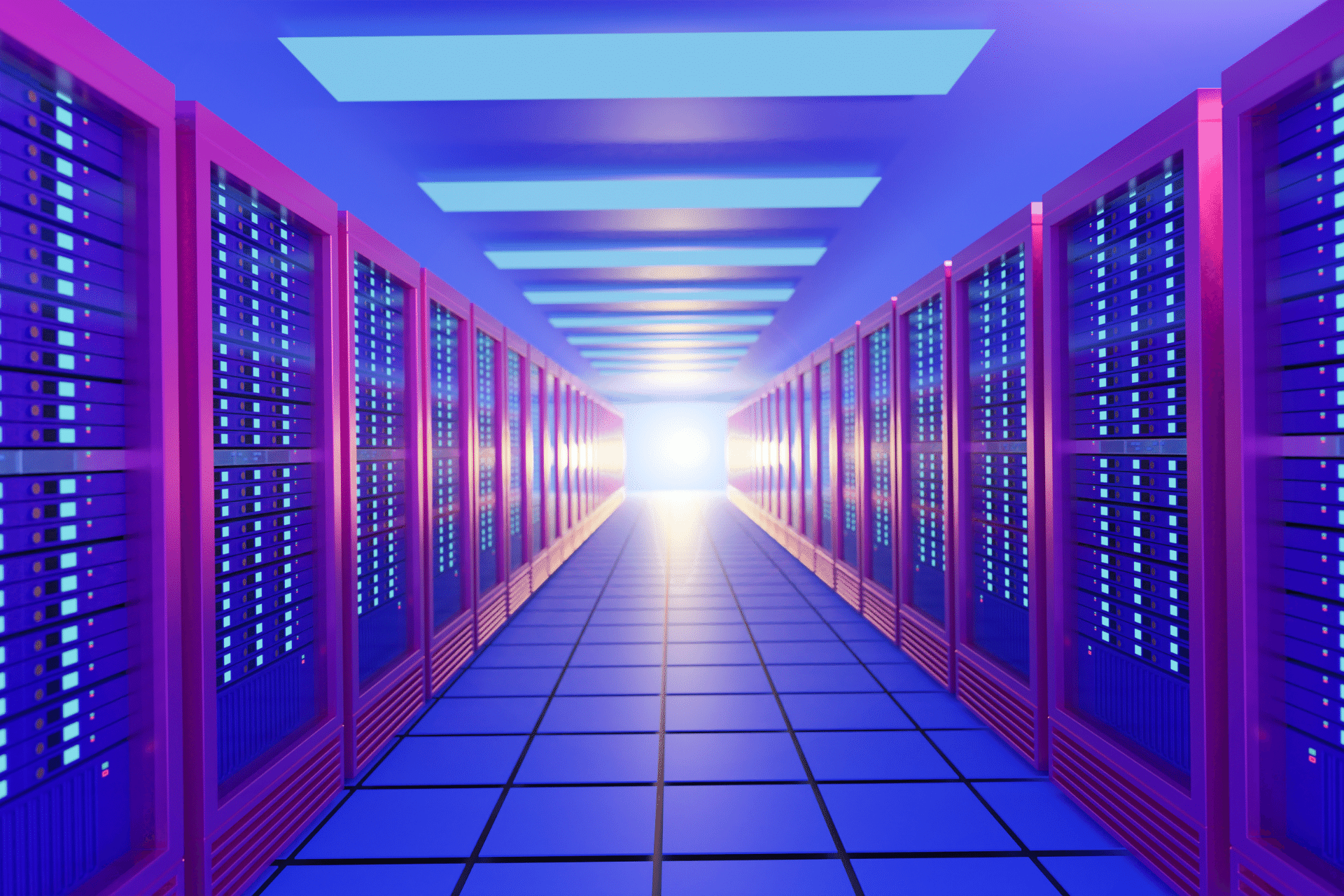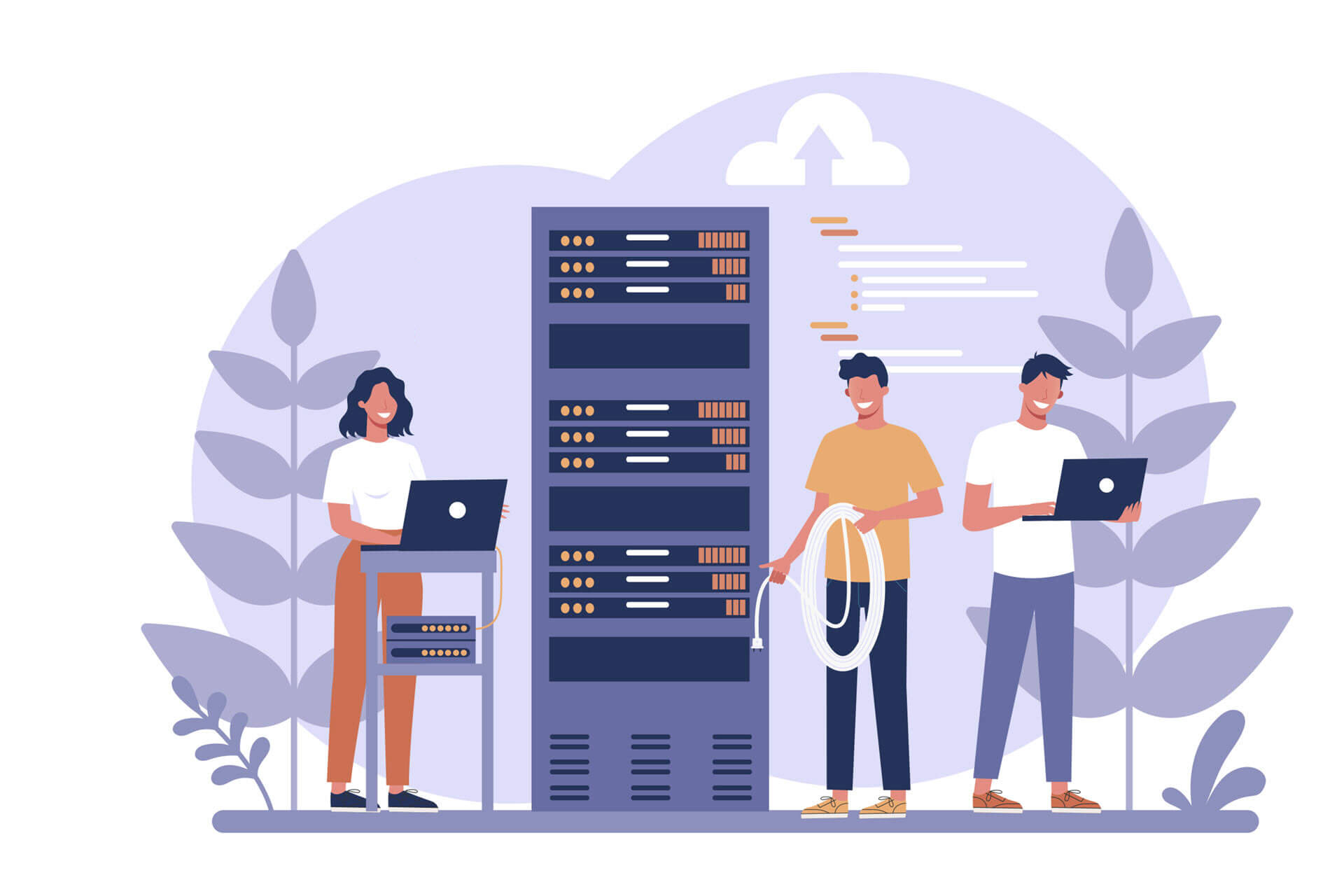Selecting the right location for a data center goes far beyond just securing a large plot of land. Companies interested in building a brand-new facility must go through an extensive list of considerations before they begin construction.
An optimal site reduces the total cost of ownership (TCO) and extends the new facility's life span. Good site selection also guarantees that companies will not have to migrate the data center any time soon, which is a complex, time-consuming, and highly costly process.
This article takes you through everything experts consider during data center site selection. Jump in to see the most critical factors that help identify an optimal location for an efficient, secure, and sustainable data center.
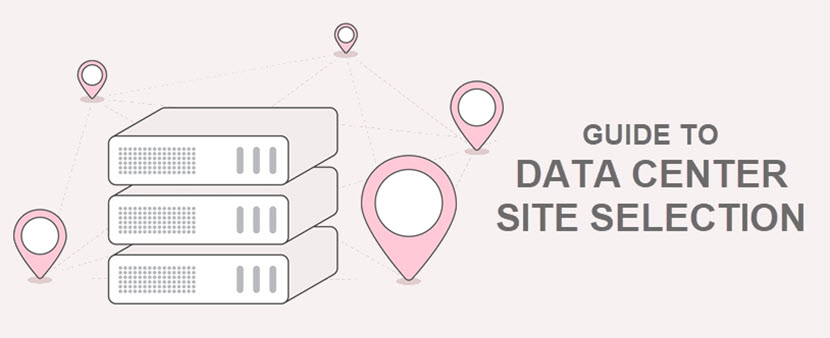
More interested in colocation than building a brand-new data center? If so, read our guide to data center selection and check out pNAP's colocation services if you want to set up your equipment in Phoenix, Arizona.
Why Is Site Selection for Data Centers Important?
Site selection is a crucial decision that influences the new data center's overall efficiency, reliability, and longevity. Choosing an optimal site location is vital regardless of the facility's tier classification, although each tier has different location-based requirements.
A well-chosen site reduces risks, helps companies meet performance expectations, and contributes to sustainable operations. Meanwhile, choosing the wrong site often results in inefficiencies and problems, such as:
- Inadequate power supply.
- Frequent and prolonged downtime.
- Poor connectivity.
- Excessive cooling costs.
- Increased latency and slower data transmission speeds are observed.
- Limited access to skilled labor.
- Vulnerability to natural disasters.
- Poor employee retention rates.
- Difficulties in meeting regulatory compliance.
- Slower equipment repairs.
- Challenges of expanding the facility to meet growing business needs.
In the short run, these issues are more headaches than definite deal-breakers. However, in the long term, they can compromise the data center's ability to function optimally and deliver a worthwhile ROI.
The best way to ensure optimal data center site selection is to consider all location-related factors, which we outline in the rest of this article. The choice must result from a close collaboration between all stakeholders (upper management, IT, finance, etc.), which should work together from the project's inception.
Is an entire data center too much for your current IT needs? If so, your business is likely a better candidate for a server room you can set up on-site at the office.
Things to Consider During Data Center Site Selection
Once you find an available plot of land within your allocated budget, the potential location must go through a thorough evaluation. Below is a detailed examination of everything you must consider when assessing a potential site for data center construction.
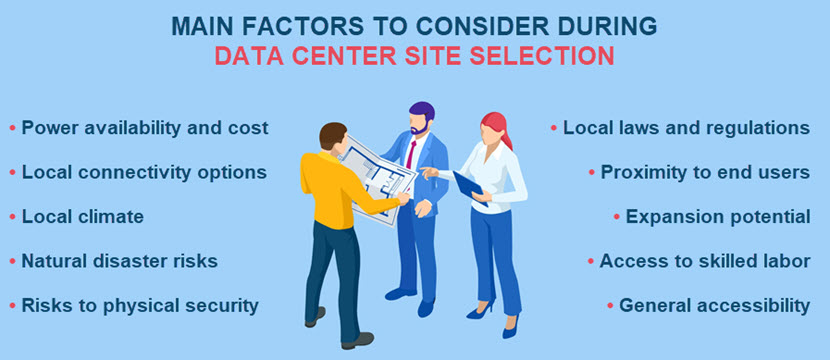
Power Availability and Cost
Data centers are power-hungry facilities that require a continuous and reliable supply of electricity for servers, cooling systems, and other essential infrastructure.
Ensuring that a data center has access to a stable and affordable power supply is crucial for maintaining uptime and reducing operational risks. Power interruptions lead to costly downtime, while high electricity costs make the data center financially unviable.
Here is what we recommend doing when assessing the power-related characteristics of a potential data center site:
- Evaluate the stability and reliability of the local power grid.
- Choose locations near renewable energy sources (wind, solar, hydroelectric) to reduce your carbon footprint and secure lower energy costs.
- Check whether multiple electric providers service the site. Multiple providers mean more competitive pricing, plus you can use one vendor as a backup power source.
- Explore local incentives for energy efficiency. Some governments offer tax breaks or rebates for facilities with energy-saving technologies.
- Check whether local power providers are open to long-term contracts that provide favorable rates.
- Check whether the site is compatible with energy-efficient technologies and practices that help reduce overall power consumption and costs.
Failing to consider power availability and costs can have severe consequences for a data center. If the power supply is unreliable or insufficient, the facility may experience frequent outages, which lead to operational disruptions and potential data losses. High power costs can also erode profit margins and make the data center economically unsustainable.
Local Connectivity Options
A data center's effectiveness relies heavily on its ability to connect with networks and end-users efficiently. Proximity to high-speed fiber-optic networks and major telecommunications hubs greatly influences the performance of the data center.
High-speed, low-latency connections ensure data moves quickly and efficiently between the data center and its users. Good connectivity also facilitates seamless integration with other data centers, cloud services, and content delivery networks (CDNs).
Here are the best practices worth knowing when evaluating connectivity for a potential data center site:
- Choose a location near major fiber-optic routes and telecommunications hubs to ensure low-latency connections.
- Verify that the local infrastructure can support high bandwidth requirements.
- Ensure the site has access to multiple network providers to avoid single points of failure. Multiple fiber paths and diverse routes protect against outages.
- Look for locations with opportunities for direct peering arrangements to reduce latency and improve performance.
- Consider whether the site is close to any emerging 5G infrastructure or edge data centers that will help you future-proof the facility and enable faster access to end-users.
- Examine the historical performance and reliability of the local network infrastructure to assess its suitability.
Poor connectivity leads to slower data transfer rates, increased latency, and diminished user experience. These issues often affect the data center's ability to meet service level agreements (SLAs) and customer expectations.
Check out our carriers page to see the extensive list of all the carriers and connectivity options you'll find in phoenixNAP's data centers.
Local Climate
The local climate plays a significant role in determining how much energy you'll need to maintain the appropriate hardware temperature.
In cooler climates, data center owners can use natural cooling methods like free air cooling, which reduces the need for energy-intensive cooling systems. Conversely, in hotter climates, the increased demand for cooling can drive up operational costs since you will likely have to rely on liquid-based cooling.
Here are a few tips to keep in mind when considering the local climate during data center site selection:
- Ensure the site has manageable humidity levels to prevent condensation and corrosion of equipment.
- Consider whether the location has extreme seasonal shifts.
- Choose a location with a cooler climate to leverage natural cooling methods and reduce energy consumption.
- Consider the potential impact of climate change on future cooling requirements and operational costs.
- Ensure the chosen site has adequate water resources if you plan to use water-based cooling systems.
- Check the altitude of the potential site. Higher-altitude locations have lower air density, which can impact the effectiveness of air-cooling systems.
An unfavorable climate often leads to ineffective cooling, causing overheating and resulting in issues such as hardware failures, reduced equipment lifespan, and unplanned downtime.
Natural Disaster Risks
A critical consideration during data center site selection is the likelihood of natural hazards (earthquakes, floods, hurricanes) in the area. These events can disrupt operations or cause significant damage to the facility.
By selecting a site with a lower risk of natural disasters, companies minimize the likelihood of costly disruptions. Additionally, disaster-resilient locations often translate to lower insurance premiums and disaster recovery (DR) costs.
Here are a few best practices experts keep in mind when evaluating the natural disaster risk of a potential data center site:
- Prioritize sites in regions with lower probabilities of natural disasters, such as areas with low seismic activity and minimal flooding risk.
- Evaluate the site's historical data and geographic conditions (land elevation, soil stability) to understand the likelihood and impact of natural disasters.
- Evaluate the local emergency response infrastructure, such as the proximity to fire stations, hospitals, and emergency services.
- Consider the long-term implications of climate change that may increase the frequency and severity of natural disasters. Sites currently considered low risk may face higher risks in the future.
- Check whether the site allows you to implement earthquake-resistant construction or elevated structures.
- Continually develop comprehensive business continuity and disaster recovery plans, even if you construct a data center in a low-risk area.
Failing to consider natural disaster risks can have devastating consequences for a data center. If a facility is located in an area prone to natural hazards, it is more likely to experience disruptions caused by disasters, resulting in significant operational downtime, data losses, and equipment damage.
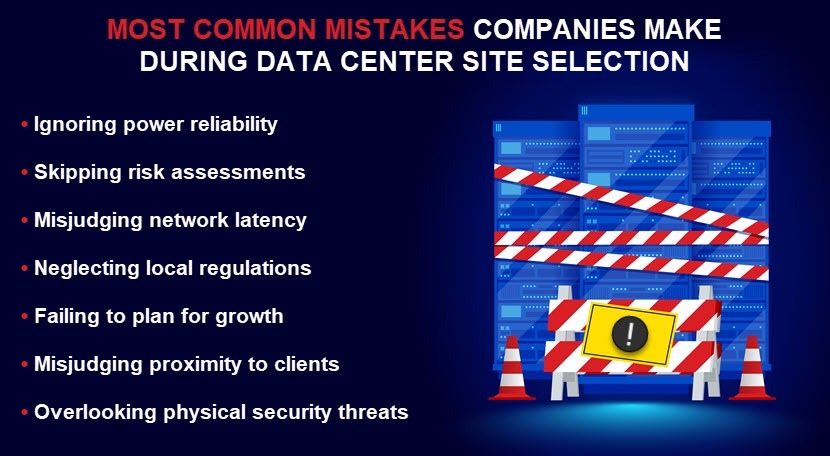
Risks to Physical Security
Data centers house critical infrastructure and sensitive information that must be protected from external threats. If the facility is in an area with high crime rates, it becomes vulnerable to unauthorized access, theft, and vandalism.
Here are a few tips to remember when assessing a site's potential in terms of physical security:
- Select a site in a region with a low crime rate to reduce the risk of incidents.
- Consider how easy or difficult it would be to secure the site physically.
- Account for the political stability of the region. Areas with high political risk pose threats to security and operational stability.
- Check for natural barriers (e.g., rivers, forests, elevation) that provide an extra layer of security by making it more difficult for unauthorized individuals to approach the facility.
- Assess the proximity of the site to law enforcement agencies.
Even if you select a low-risk site for your data center, you should invest heavily in physical security measures. Here are a few tips:
- Implement multiple layers of access control, including biometric scanners, key cards, and security checkpoints, to effectively restrict unauthorized access.
- Employ trained security personnel to provide a physical presence and respond to incidents.
- Deploy comprehensive surveillance systems to monitor the facility, including 24/7 CCTV cameras and motion detectors.
- Use reinforced doors, secure perimeters, and other physical barriers.
- Develop an emergency response plan that includes protocols for various physical security threats.
- Restrict car access and have security checks for delivery vehicles.
Our article on data center security offers an in-depth look at what it takes to keep a facility safe from both physical and digital threats.
Local Laws and Regulations
You will have to operate within the legal framework of the chosen location, so you should ensure the data center site has favorable local regulations.
Regulations often include local data privacy laws, environmental standards, and energy consumption rules. Ensuring that a data center is compliant from the outset of construction is essential for avoiding legal and financial repercussions.
Here are a few best practices when considering a site based on local regulations:
- Engage legal experts to assess the site's suitability. External experts familiar with the region will help you navigate local regulatory requirements.
- Ensure the up-and-coming data center complies with local environmental laws related to energy efficiency, emissions, and waste management.
- Research the local regulatory environment to ensure your data center will align with all relevant laws.
- Understand the local permitting process for expansions. Some regions have specific requirements or approval processes for infrastructure upgrades.
- Research local labor laws and regulations that could impact hiring practices.
- Research upcoming regulation changes to ensure you can adapt to new compliance requirements.
Failure to consider regulatory compliance during site selection can have severe consequences for a data center. Non-compliance with local regulations often results in hefty fines, legal actions, costly retrofitting, and increased operational expenses. Some more severe violations can also result in the loss of business licenses or forced closure.
Proximity to End Users
Proximity to end users is a crucial consideration during data center site selection. The closer the facility is to its end users, the faster and more efficiently it can deliver content, services, and applications.
This factor is significant for businesses that require low latency and high operational performance. Low latency is crucial for various use cases, including video streaming, online gaming, and financial transactions.
Additionally, being closer to end users can lower bandwidth costs and reduce the likelihood of network congestion. Shorter data transmission distances also reduce energy consumption and carbon footprints, which is vital for companies focused on sustainability.
Most companies follow these best practices when considering proximity to end users for a data center site:
- Map out where the majority of end users are located to determine optimal site locations. Only build a data center in an area within the acceptable range.
- Ensure the site has access to a robust network infrastructure that can support fast and reliable data transmissions to end users.
- Study where competitors have placed their data centers to identify strategic advantages or gaps in service coverage.
- Choose locations that can accommodate future expansion as the user base grows or shifts.
- Consider exploring peering agreements with local ISPs or network providers to further improve data transmission speeds and reduce latency.
If the facility is located too far from its users, increased latency will lead to slower load times and a subpar user experience. These problems result in customer dissatisfaction, lower bottom lines, and a competitive disadvantage.
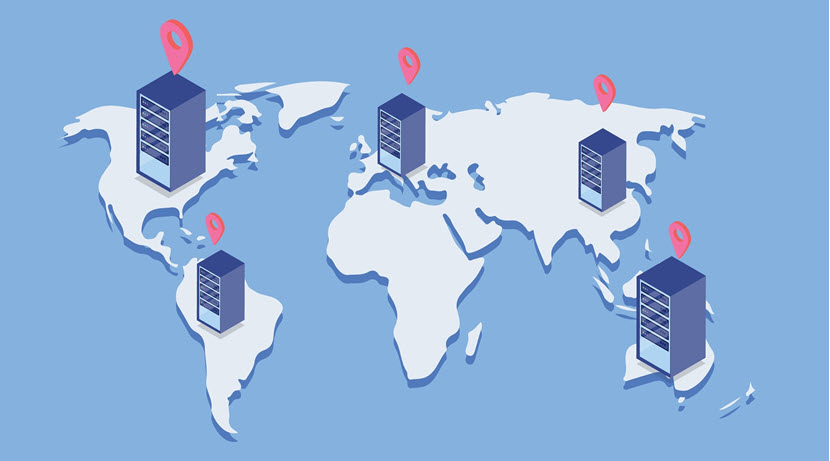
Expansion Potential
Data centers typically begin with a specific capacity, but their need for additional servers, storage, and cooling systems increases over time. Selecting a site that allows for easy expansion helps future-proof the data center by ensuring it can accommodate growing needs without major disruptions or excessive costs.
Furthermore, sites with enough room to expand provide flexibility, allowing businesses to adapt to market changes and technological advancements.
Here's some general advice that will help you evaluate a data center site in terms of expansion potential:
- Ensure the site has enough land or building space to support future expansions, including additional data halls, power systems, and cooling infrastructure.
- Design the data center with a modular approach that allows incremental expansions without disrupting existing equipment.
- Consider using modular power and cooling systems, which you can expand or replace with minimal disruption to operations.
- Verify that the site's zoning regulations allow for future expansions and that there are no legal barriers to growth.
A site with limited expansion potential can lead to operational bottlenecks, forcing the business to invest in costly upgrades or move to a new location. Both options are time-consuming and expensive, so most companies that choose a site with limited expansion potential often operate at a constrained capacity.
Choosing sites that can accommodate future expansion is especially vital for hyperscale data centers that plan to run tens of thousands of servers at one location.
Access to Skilled Labor
Your new data center will require a workforce with specialized technical skills. To run the facility, you will need to hire IT professionals, engineers, security personnel, and support staff, which means your site must have access to a large talent pool.
Here are a few best practices when assessing a potential data center site's access to skilled labor:
- Evaluate the availability and experience levels of IT professionals, engineers, and other technical staff in the area.
- Check whether there are other data centers or technology companies in the area. A strong industry presence can indicate a robust talent pool.
- Research how competitive the job market is in the area. This analysis helps gauge the difficulty of recruiting and retaining talent.
- Choose a location where the cost of living and quality of life are attractive to skilled workers.
- Select sites close to universities or technical schools that offer relevant programs to ensure a steady supply of qualified graduates.
If the facility is located in an area with a limited talent pool or a prohibitively high cost of living, you will struggle to attract and retain qualified professionals. The lack of a skilled workforce results in increased downtime, slower response times to technical issues, and a higher likelihood of errors.
General Accessibility
A data center depends on the regular delivery of hardware and maintenance parts necessary to ensure continuous operation. Efficient transportation networks, including roads, railways, and airports, are essential for the timely delivery of equipment.
Here are a few best practices when assessing the general accessibility of a potential data center site:
- Select a site close to major highways, airports, or railway stations to facilitate the quick and easy movement of goods and personnel.
- Choose a location near key suppliers and service providers to reduce lead times for parts and maintenance.
- Ensure the site is accessible via well-maintained roads that can accommodate large delivery vehicles.
- Ensure that emergency services can quickly access the site in case of incidents.
- Ensure that there is sufficient area around the building for parking, water, fuel storage, and access for delivery vehicles.
- Consider the impact of transportation options on the workforce's ability to commute to the site.
Poor accessibility can lead to delays in the supply chain, increased operational costs, and difficulties in staffing the data center. In emergencies, the inability to quickly transport necessary parts or personnel can result in prolonged downtime and significant financial losses.
Our data center in Phoenix ticks all the boxes covered in this article. Schedule a personalized virtual tour of phoenixNAP's flagship data center to see what a well-situated facility looks like.
Never Rush into Data Center Construction
Choosing where to build a data center is a critical decision that can have serious financial and operational consequences if you make the wrong choice. Use what you learned in this article to ensure that location-related factors do not compromise your new facility's reliability or life span.

